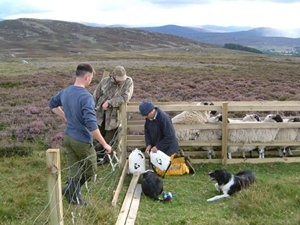 Ticks are increasing in many parts of the Scottish Highlands and are associated with reduced grouse densities and poor shoot returns. Research by the GWCT in northern England has shown that regular treatment of sheep with acaricide can reduce parasitisation rates on grouse chicks, reduce the prevalence of LIV and improve shooting bags. The host system is relatively simple in northern England with the main hosts being grouse and sheep, but in many parts of Scotland it becomes complicated by the additional presence of red deer and mountain hares as alternative tick hosts. These large mammals may reduce the effectiveness of sheep used to ‘mop’ up ticks.
Ticks are increasing in many parts of the Scottish Highlands and are associated with reduced grouse densities and poor shoot returns. Research by the GWCT in northern England has shown that regular treatment of sheep with acaricide can reduce parasitisation rates on grouse chicks, reduce the prevalence of LIV and improve shooting bags. The host system is relatively simple in northern England with the main hosts being grouse and sheep, but in many parts of Scotland it becomes complicated by the additional presence of red deer and mountain hares as alternative tick hosts. These large mammals may reduce the effectiveness of sheep used to ‘mop’ up ticks.
The most robust way to assess the levels of alternative hosts at which sheep tick mops remain effective would require large replicated field experiments; this luxury has to-date not been forthcoming. Mathematical models have explored this balance in mammal densities (Porter et al. 2011), however these models include many assumptions and have not been field tested.
In the absence of an experimental system, then a correlative approach remains the best option. In 2012 and 2013 we increased our efforts to gather data on tick burdens, body condition of grouse chicks and estimates of chick survival with the aim of relating the data to tick-host abundance and on-going management regimes across a range of sites in Scotland. These data are currently being assessed and will be made public once analyses have been completed.